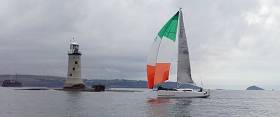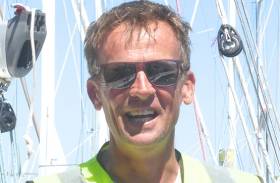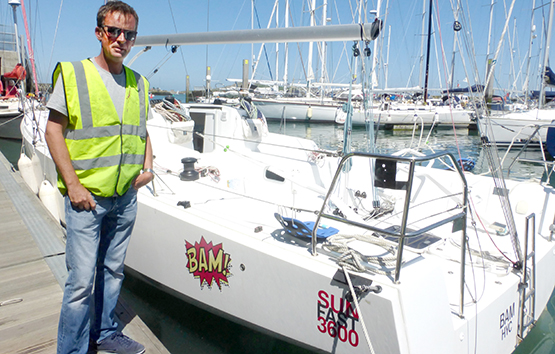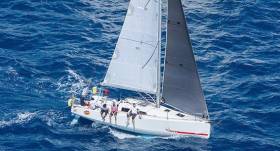Displaying items by tag: Conor Fogerty
Close Solo Fastnet Race For Howth Yacht Club's Conor Fogerty
Conor Fogerty's Sunfast 3600, Bam from Howth Yacht Club continued her 2016 campaign with the inaugural SORC (Solo Offshore Racing Club) run, Solo Fastnet, from Cowes to the Fastnet, finishing at Plymouth, a distance of 605 nautical miles, writes BAM shore manager John Forde.
An action packed delivery from Howth to Ocean Village Marina in Southampton, saw 20.4 knots clocked off Portland Bill on a broad reach fling a battered delivery Figaro Main and a beautifully cut Philip Watson no.5 /reaching sail. This, perhaps, should have foretold what was in store for the 46 plucky contestants who had gathered for this iconic sailing test. The nationalities, mainly British and French, included German, Finnish, Australian and two Irish entries. Besides Conor's class 1 IRC rated Bam, Jim Schofield from Poolbeg YC had entered his classic Nicholson 32 'Thisbe', the lowest ranked boat in class 3 on an IRC rating of .848.
The Fastnet Race is one of the great RORC races and memories will remain long of the tragic 1979 Race. Recent races have witnessed some pretty tough racing conditions for what are mainly Corinthian sailors, albeit some with tremendous sailing experience and expertise to include previous OSTAR ( Plymouth - New Port RI ) participants and winners, Trans Quadra trans Atlantic race winners, as well as Double Handed RORC Fastnet winners. The last big blow Fastnet of 2007 saw just one in five boats reach and round the Rock.
In contrast, there were only two retirees who did not come to the line, and eventually 19 out of 46 managed to finish.
 Conor Fogerty on his Sunfast 3600, prepares to leave Ocean village marina for the Solo Fastnet start. Photo: John Forde
Conor Fogerty on his Sunfast 3600, prepares to leave Ocean village marina for the Solo Fastnet start. Photo: John Forde
However that was as good as it got for the fleet at the 11.30 start line. Average wind speeds from the South West of 25 knots gusting 30/35 together with an ebbing tide saw 10–foot standing waves off the Needles.
Post race, a local sailor based in Cowes, reported having heard of these legendary standing waves off the Needles point, but never having witnessed such conditions, until this race began that is.. The fleet therefore started and continued on a cold and wet, wind tossed beat into the first night and beyond.
There were many early casualties due to boat failure; auto pilot / charging issues, serious gear failure, sails/sheets fouling sail drives and indeed physical casualties, exhaustion/sickness. Broken ribs in one case and a tooth knocked out in another were mere irritations for two participants who carried on.
Our intrepid Howth hero started on full main and when questioned after by a fellow racer as to his sanity, replied “ I blew my first reef and had no option “, narrowly avoiding a port – starboard collision with a quick thinking competitor who allowed him pass in front.
A ripped leech on a J2, a blown halyard and a quickly deteriorating main completed the damage inventory.
Reports of no sleep for the first 24 hours was common as progress was made down the Inshore stretch of the race along the Jurassic Coast, crossing outside Poole Bay, Portland Bill, Lyme Bay on to Start
Point the Lizard and Lands End to the first tactical call at the Lands End TSS The TSS could not be entered save incurring time penalties.
Most of the lead boats went south towards the Scilly Isles whilst following boats split in between. There was an early lead on time for French Class 2 Raging Bee in a JPK 1010. The lead boats comprised a group of French in a range of JPKs , and the English and lone Irishman in the 3600's, The SF 3200's also dicing at the front, with the only female entry Deb Fish more than holding her own.
The first night saw a large proportion of retireses. This growing band of brothers gathered, ashore at the RWYC and Sutton Marina and local Hostelries in the magnificently situated maritime City of Plymouth.
As the band of retirees gathered after a second gale battered the fleet off the South coast of Ireland on the 3rd day of racing the pace increased. Both offshore and ashore!
The remaining open 40 with Finnish Skipper Ari Kansakoska blew his main but still managed to finish, nursing it home in less decreasing winds on the return leg. Bam, Bellino and several other Sunfasts plus the French in the JPK 1010's swapped the lead, with Bam stealing a decisive tactical march before the Fastnet and rounding First.
Alas no prizes at half time....
The lead continued to change on the return leg with light airs now predominating to the TSS at Lands End/Scilly Isles.
On Wednesday night, day 4, a group of new found Irish supporters gathered round various devices to track the latest progress on the superbly functional and informative YB tracking system. Before last orders (late) in The Fishermans Arms at the top of one of Plymouth's many steeped cobbled 18th century streets, it seemed a second tactical battle had been won by Fogerty over the experienced Rob Craigie in Bellino.
Bellino went in under the headland at Lizard Rock, about 40–miles to finish in a dying breeze and slowed to 1.5 knots. Bam gybed south in an effort to keep the A2 filled. We could see three knots on the tracker compared to Bellino's 1.5. It seemed a first on the water and class was there instead of simply accepting a “follow the leader home” second, as Bellino had 3 miles on Bam.
'Fortune did not follow this brave move'
Alas on this, the occasion of his first solo offshore race, despite huge offshore big boat and fully crewed experience, fortune did not follow this brave move.
A large hole appeared off shore and the inshore boats found some land breeze to creep on towards the finish in Plymouth Sound, early next morning Thursday the 7th July.
A welcoming committee of competitors and friends greeted each finisher with a great cheer and a cold beer and in some case a much needed fag....
Time to party, boats were docked, tied up and left as cold liquid refreshments were the breakfast choice of all, despite most sailors reporting snatches of 20 mins max and little food. Somehow 35 knots don't make for fine dining or even dining in cases, it seems....
When the skipper was informed that the shore support was wrecked, later in the day the question rang out “ how could you be wrecked tracking the race (Tactical Support ) when we're after doing a 5 day solo “? Try 7 days ashore with a bunch of thirsty sailors and you'll know how...
Bam finished 4th in Class and for a first Solo in such illustrious company this was a tremendous achievement. The eventual winner on corrected was Will Sayer in his Class 3, Sigma 33C due to the fleet compressing at points during the leg back. He had seriously contemplated giving up at Lands End on the way out when cast adrift from the top markers...
 HYC's Bam competing in last month's Round Ireland race. Sailing solo last week, skipper Conor Fogerty was in contention in the Solo Fastnet race Photo: Afloat.ie
HYC's Bam competing in last month's Round Ireland race. Sailing solo last week, skipper Conor Fogerty was in contention in the Solo Fastnet race Photo: Afloat.ie
The remainder of 2016 sees Bam compete in a number of RORC fully crewed events to include the “Ile d Òuessant ” in August and finally the Middle Sea Race in October to complete a remarkable year, after a first in The RORC 600 and a third in the Round Ireland race. Conor and Rob Craigie are both going for the RORC top sailor of the year award a with a one–all at this point .
Next year is the OSTAR and Conor will be commencing a sponsorship campaign to fund this expensive attempt when he again attempts to put Irish amateur sailing on the world map.
Just ten months after sailing away into the wide blue yonder, Conor Fogerty of Howth has returned this week with his SunFast 3600 Bam with more than 12,000 miles logged in just ten months away, and a Class win recorded in the RORC Caribbean 600 as “just another element” in a remarkable Atlantic circuit cruise writes W M Nixon.
He will barely have time to savour being home before being swept up into the Volvo Round Ireland Race in a fortnight’s time. When Afloat.ie caught up with him at lunchtime today, Bam was being lifted in Howth Marina in order to get a proper assessment of her weight, as she rates a whole 8 points higher than the other SunFast 3600 entered for the Volvo Round Ireland, and the reasons for this have to be identified.
Then next stage is participation in tomorrow night’s ISORA Race from Dun Laoghaire to Douglas in the Isle of Man for some crew qualifications for the Ireland circuit, and when this necessary business has been sorted, maybe there’ll be time to properly savour the quality of the achievement of Bam! and her skipper.
While he got to the Caribbean from the Canaries by way of the ARC, and raced fully-crewed in the RORC Caribbean 600, in order to qualify for events such as the OSTAR he sailed home single-handed non-stop from St Maarten back across the Atlantic to the Azores, while for the final 1,200 mile passage from the Azores back to Howth, he was crewed by longtime shipmate Daragh Heagney. As our photos show, Conor Fogerty has returned looking hyper-fit and well, while Bam! looks as if she has only been away for a sail round the bay.
Conor Foger with Bam! in Howth – his Jeanneau SunFast 3600 looks as though she's just back from a day sail round the bay, rather than 12,000 mile Transatlantic Circuit cruise. Photo: W M Nixon
When Conor Fogerty’s beamy new Jeanneau Sunfast 3600 Bam first appeared on Howth Marina, most observers wanted to like her. After the grey years of the recession, BAM was like a breath of fresh air, a wonderful free-wheeling yet mainstream take on the all-conquering JPK range, with the same twin rudder configuration. Yet by being from Jeanneau, she had an air of accessibility, whereas you’ve to queue for a JPK.
Nevertheless it was clear that the short-leg courses of the racing in the greater Dublin region were scarcely going to allow her to spread her wings, and even in longer ISORA events, much of the time you’re unlikely to get a pronged period of the kind of conditions that allow BAM to fly, and sail up to and beyond her rating.
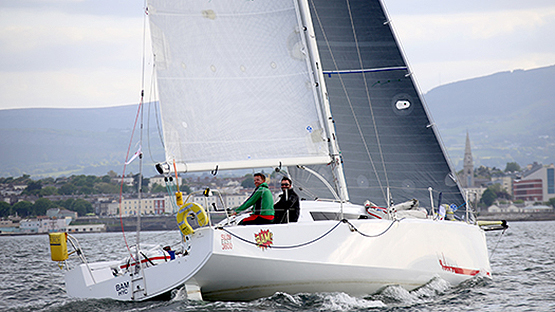
BAM in Dublin Bay. She looked great, but gave every indication of needing wide open spaces, plenty of breeze, and preferably a bit of sunshine to give of her best.
But with a mighty leap, our hero freed himself. BAM and her skipper and some mates took off in the Autumn, and scampered across the Atlantic in the ARC to line themselves up for the RORC Caribbean 600 at Antigua on Monday February 22nd.
In the race, BAM was never out of the frame, and other Irish-crewed boats doing well too. But while most of the other Irish personnel had crossed the Atlantic in comfortable big jetliner style, there was the little BAM racing her heart out after sailing every inch of the way from Howth just to get there. It was inspirational stuff, brought to a perfect conclusion with the IRC 3 overall win.
The story will go on, and BAM’s skipper has further projects to implement during his Atlantic circuit venture. But for now, Conor Fogerty is a very worthy “Sailor of the Month (Racing)” for February 2016.

Wishing him well – Howth YC Commodore Brian Turvey with Conor Fogerty at a party in the clubhouse to send BAM on her way across the Atlantic last year. Brian Turvey later caught up with BAM and her crew in Antigua in late February, having jetted out to join the Howth crew on the First 40 Southern Child which finished third in IRC 2 in the RORC Caribbean 600 2016.
Irish Sailors Up For It In RORC Caribbean 600
For those reared in the simple certainties of the course in the offshore classics like the Rolex Fastnet Race and the even more clearly defined Volvo Round Ireland Race, the multi-island RORC Caribbean 600 which starts tomorrow (Monday) morning at Antigua is a strange beast writes W M Nixon.
Set against the straight-line austerity of other long-established classics such as the Newport-Bermuda and the Rolex Sydney-Hobart, its weaving course makes it seem almost fussy. But in a typical February in the Northern Hemisphere, people will happily race round as many islands as are required to make the magic 600 miles total. Just so long as it’s in those marvellous Caribbean sailing and climatic conditions which contrast so totally with what many other areas of the Northern Hemisphere are experiencing in this dank dark cold month.

It’s a busy course – with so many islands to be ticked off, navigators could usefully employ the services of a continuity director…
Eleven islands are required to act as race marks in order to put sufficient mileage in the course. But with 77 boats – many of them noted superstars – tuned up and ready to go, it’s clear that the huge variety of legs both long and short which have to be sailed is no deterrent, and Irish interest is high both in terms of participation, and in the presence of international contenders expected for the Volvo Round Ireland Race in June.
Then too we’ve a certain proprietorial interest. The Caribbean 600 having been inaugurated as recently as 2009, it’s a modern classic. And the fact that on its first staging, it was won overall by Adrian Lee’s Cookson 50 Lee Overlay Partners from Dun Laoghaire, makes it extra special. For in her previous life as Ger O’Rourke’s Chieftain, the Lee ship had been overall winner in the Rolex Fastnet Race 2007, providing the rare if not unique situation that the same Irish boat won two classics in the space of just 18 months.
Six years later, the ever-green Cookson 50 is such a good all-rounder that she’s still very much in the hunt, and Lee Overlay Partners is in the listings for tomorrow’s start, the smallest boat in the six strong canting-keel division which includes such giants as Jim and Kristy Hinze Clark’s mega-powerful hundred footer Comanche.
We’ve interest throughout the race, as in addition to Lee Overlay Partners, the fleet includes two Howth Yacht Club crews. Howth sailors with the likes of Kieran Jameson on the strength have already got involved in past seasons in the Rolex Middle Sea Race with a Performance Yacht Charter’s First 40, and now with two of PWC’s boats of this proven marque on the other side of the Atlantic, there with PYC’s Lucy Johnson on Southern Child are Howth men raring to go Caribbean island-rounding. Much of the Howth team assembled by Darren Wright for the 2014 Rolex Middle Sea Race are re-joining the same boat, Southern Child, and their lineup incudes Kieran Jameson, Frank Dillon, Rick de Neve, Jonny White, Colm Bermingham, while new talent in the form of Michael Wright, recently-retired HYC Commodore Brian Turvey, and young Howth K25 squad member Luke Malcolm are also on the strength.
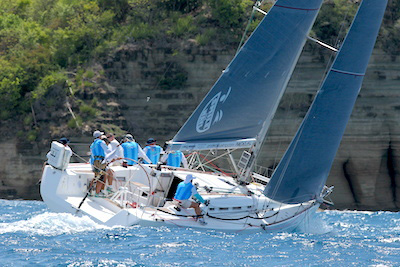
One of the two Howth crews will be racing the First 40 Southern Child, which they’ve already campaigned in the Rolex Middle Sea Race
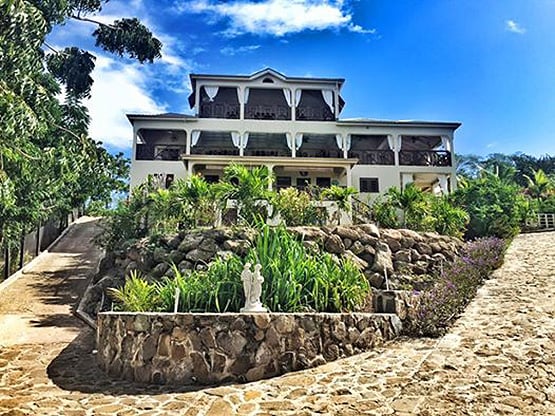
Howth Yacht Club Headquarters for the RORC 600: Villa Touloulou
Up against them to provide a spot of in-club competition is HYC’s Conor Fogerty who is doing an Atlantic circuit as a mix of racing and cruising with his new Sunfast 3600 Bam, a boat which might have been designed with RORC Caribbean 600 enjoyment in mind. Bam’s racing crew coming out from home include Simon Knowles, Daragh Heagney, Paddy Gregory, Roger Smith and Anthony Doyle. After Bam sister-ship Red Shift’s success in last year’s race, Conor Fogerty has great hopes for his stylish boats showing once tomorrow has seen the start – usually a very challenging business in itself – get cleanly away.
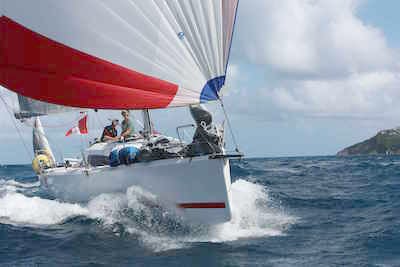
Conor Fogerty’s Sunfast 36 Bam from Howth is doing the RORC Caribbean 600 as part of an Atlantic odyysey
Ireland’s own RORC Commodore Michael Boyd of the RIYC, who won the Gull Salver for best-placed Irish boat in last year’s Fastnet Race with the Grand Soleil 43 Quokka 8, is helping to pass the time while waiting for delivery of his new JPK 10.80 by racing the Caribbean as navigator on Andy McIrvine’s Grand Soleil 46 Bella Donna.
As for pointers towards the Volvo Round Ireland Race in June, the two MOD 70 trimarans already signed up for it, Lloyd Thornburg’s Phaedo 3 and Concise 10 (Tony Lawson & Ned Collier Waefield) are both g0ing for the Caribbean 600.

Lloyd Thornburg’s MOD 70 Phaedo 3 is one of two sister-ships entered for the Volvo Round Ireland Race 2016 which are also doing the Caribbean 600, the other being Concise 10.
In fact it’s a very eclectic fleet, as Eric de Turckheim’s noted Commodore’s Cup contender of 2014, Teasing Machine from France, has somehow got herself to the Caribbean after being far away to cut a successful swathe through the recent Rolex Sydney-Hobart Race. And up towards the top of the fleet, the 72ft mini-maxi Momo, which was best of the bigger boats in last summer’s Fastnet, find herself up against Hap Fauth’s similarly-sized superstar Bella Mente, which had to scratch from the 2015 Fastnet Race for personal reasons after a blisteringly successful Cowes Week, but is now set to go in a race in which she is the defending champion.

Back to the fray. Having been forced to scratch from the Rolex Fastnet 2015 in which she was a favourite, Hap Fauth’s 72ft mini-maxi Bella Mente is very much in the hunt in tomorrow morning’s RORC Caribbean 600, in which she is defending champion.
The 72ft mini-maxis seem to be the favoured size of boat o the most recent peformances, as Nik Zennstrom’s Ran won in 2012, George Sakellaris’s Shockwave won in 2014, and Bella Mente won in 2015. But the evergreen Cookson 50 is a good steady bet, with Lee Overlay Partners; win in 2009, and Ron O’Hanley’s with Privateer in 2013.
The RORC Caribbean 600 starting process gets under way at 1030hrs local time tomorrow morning off Antigua, and there are going to be 77 very busy crews having more than a few dry-mouth moments before they get clear away around this island’s beautiful east coast.




























